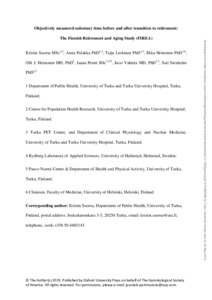Objectively Measured Sedentary Time Before and After Transition to Retirement: The Finnish Retirement and Aging Study
Suorsa Kristin; Pulakka Anna; Leskinen Tuija; Heinonen Ilkka; Heinonen Olli J; Pentti Jaana; Vahtera Jussi; Stenholm Sari
https://urn.fi/URN:NBN:fi-fe2021042827532
Tiivistelmä
Background: Retirement is associated with an increase in self-reported daily sedentary time, but no longitudinal evidence exists on how objectively measured sedentary time changes during retirement transition. The aim of this study was to compare objectively measured daily and hourly sedentary time before and after retirement and examine whether these changes differ by gender and occupational status.
Methods: The study population consisted of 478 participants (mean age 63.2 years, standard deviation 1.7, 85% women) from the Finnish Retirement and Aging Study. Sedentary time was measured using a wrist-worn triaxial ActiGraph accelerometer before and after transition to retirement with 1 year interval. Preretirement occupational status was categorized as manual and non-manual.
Results: Daily sedentary time was 8 hours 10 minutes in women and 9 hours 49 minutes in men before retirement. Considering all measurement days before and after retirement, daily sedentary time increased in women by 29 minutes (95% confidence interval [CI]: 20 to 38). Especially women retiring from manual occupations showed marked increase in sedentary time (63 minutes, 95% CI: 50 to 77). When only non-working days before retirement were considered, increase in daily sedentary time among women was less marked (16 minutes, 95% CI: 7 to 25). Among men, daily sedentary time did not change in retirement transition (−7 minutes, 95% CI: −26 to 12).
Conclusions: Objectively measured sedentary time increases among women and remains at high level among men during the retirement transition. Attention should be paid to reduce daily sedentary time in retiring women and men.
Kokoelmat
- Rinnakkaistallenteet [27094]
